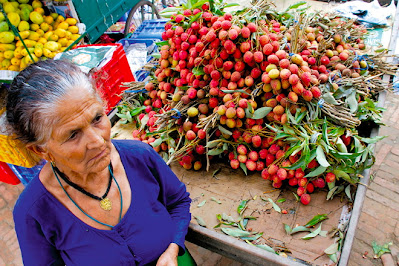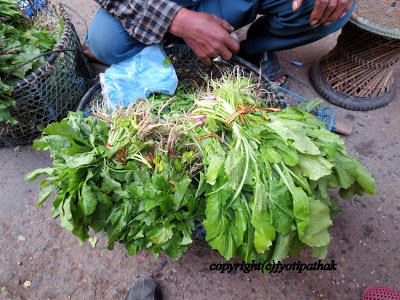Enjoy the delicious and colorful vegetable dish made with the combination of chayote squash, potatoes and spices -- इस्कुश को तर्कारी -- it will add a variety to your everyday Nepali traditional meal of Daal-Bhaat-Tarkaari  |
| Chayote Squash (Iskush ko Tarkaari) |
 |
Iskush for sale at Nepali vegetable markets in Kathmandu |
If you are a regular visitor to my blog, you will notice that I have been introducing all the unusual and unique vegetables that are grown in Nepal -- listed below are the link of my previous blog that you probably have gone through. They are Balsam Apple (barela-बरेला), Fiddlehead Fern (neuro - नीयूरो), Bauhinia (koiralo ko phool - कोइरालो), Pumpkin Shoots (pharsi ko munta - फर्सी को मुन्टा), Taro (karkalo-gaava-pidhaalu - कर्कलो-गाभा-पिँडालु), Tree Tomato (tyammatar - ट्यामटर), Ash Gourd (kubhindo - कुभिन्डो), Banana Blossom (kera ko bungo - केराको बुङ्गो), Luffa Gourd - Gheeraula (घीरौला, पाटे घीरौला) and Pointed Gourd (Parvar - परवर).
Today, I want to share with you a delicious mild flavored squash that grows on a climbing vine and Nepalese call it Iskush or Ishkush (इस्कुश). In the scientific journals, it is called Sechium edules SW.
.JPG) |
| Chayote squash growing on vine |
Chayote (pronounced chai-oh-tay) is a pear-shaped, lime-green colored squash with crispy white flesh and a single large, soft seed. Chayote is one of the easiest and fastest vegetable to grow in the warm tropical or subtropical climate (temperature) in the world. In Nepal, the chayote plants are treated as a summer annual or perennial and once the plant begin to grow, they can take over the whole garden and grow onto anything. The vine starts climbing wildly over and across the roof of village houses, over the fences, and climbing out around the trees. The chayote plant does well where there is abundance of full sun that helps to yield a lot of fruits. It is a favorite and staple vegetable for many Nepalese who live in the hilly parts of Nepal as one single plant can provide more than 75 to 90 squashes in a season. It is a constant supply of vegetable for a family all summer.
.JPG) |
| Chayote squash growing on vine along with smooth skinned Luffa Gourd |
Wikipedia states that chayote (Sechium edule) is a popular vegetable in many parts of the world; it's used widely and gives all different names – "chayote is known as christophene, cho-cho, mirliton (Creole/Cajun), chuchu (Brazil), Cidra (Antioquia, Caldas, Quindio and Risaralda regions of Colombia), Guatila (Boyacá and Valle del Cauca regions of Colombia), Centinarja (Malta), Pipinola (Hawaii), pear squash, vegetable pear, chouchoute, choko, güisquil (El Salvador), Labu Siam (Indonesia), Iskush - (इस्कुश Nepal), Pataste (Honduras),Tayota (Dominican Republic), Sayote (Philippines). It is an edible plant belonging to the gourd family Cucurbitaceae, along with melons, cucumbers and squash".
.JPG)
There are so many varieties of Chayote with different shapes, sizes, and textures. Mr. P Regmi, in his book "The Introduction to Nepalese Food Plants" describes the Iskush as "strong, climbing, tuberous rooted, scabrous, fruit mostly pyriform or ovoid, furrowed and wrinkled, green or whitish, soft spiny when immature. It is taken into cultivation mostly in the hilly region of Nepal and not grown in Tarai. Fruit is eaten either boiled or oil cooked."

The young, uppermost tender shoots and leaves of chayote vine is called iskush ko muntaa (इस्कुश को मुन्टा). They are harvested by pinching off the tender ends and cooked similar to pumpkin vine shoots. They are served as a savory vegetable dish along with freshly boiled rice. The root of chayote plant is called iskush ko jaraa (इस्कुश को जरा)is also cooked and eaten by some Nepalese. They are delicious addition to sauteed root vegetable dishes.The mild flavored chayote squash is loved by many Nepalese because the vegetable is so versatile and can be blended with various other ingredients and spices. It is also sauteed with other vegetables such as potato, and fresh or dried beans. Sometimes, it can be cooked with goat, lamb or chicken to create a variety of dishes. It has also known for excellent storage life.

Another common variety of iskush for sale at Nepali vegetable markets – the chayote is covered with thorny (prickly) spines. When I captured the picture here, I asked the vegetable vender if the squash tasted similar to smooth skinned variety. He told me, all different varieties should taste somewhat identical, except the over-matured, dry and tough ones will be,“ne mitho - नमिठो” (translation - more bland in taste).
Iskush ko Tarkaari -- the following recipe has a simple ingredients and a quick preparation, so that you can have a delicious vegetable dish that can be served with freshly cooked rice or warm Nepali breads. Let's get started with my step-by-step tutorial photographic examples with chayote squash.
 |
| These recipes were cooked with chayote that are found in the United states |
Ingredients2 tablespoons vegetable oil1/4 teaspoon fenugreek seeds1/2 teaspoon cumin seeds or brown mustard seeds 2 dried red chilies, halved and seeded
2 small red potatoes, peeled and cut into 1-inch cubes or cut into thin half slices
4 medium fresh chayote squash, peeled, seeded, and thinly sliced2 medium clove garlic, minced1 tablespoon minced fresh ginger1 teaspoon ground cuminSalt to taste1/2 teaspoon cayenne pepper1/4 teaspoon ground turmericA small pinch ground asafetida
 For the freshness of flavor, be sure to select chayote squash that are fresh, young, tender without any bruising or indention and should be heavy for its size. If you are cooking with smooth skinned variety, it can be easily peeled with a vegetable peeler. If you are using spiny chayote, the skin can be a little tough so use a paring knife to trim away the skin.
For the freshness of flavor, be sure to select chayote squash that are fresh, young, tender without any bruising or indention and should be heavy for its size. If you are cooking with smooth skinned variety, it can be easily peeled with a vegetable peeler. If you are using spiny chayote, the skin can be a little tough so use a paring knife to trim away the skin.
While peeling and cutting chayote squash, you will notice that a sticky sap (iskush ko chop - इस्कुश को चोप) is released which may cause a irritation to your hand temporarily. If you have sensitive skin, just rub some oil into your hand or peel the fruit under running water to prevent skin irritation. You may also use rubber glove while cleaning.
Image of peeled, seeded, and thinly sliced chayote squash - make sure they are cut into even pieces so that they cook at the same time.
 |
Cutting potatoes into thin slices |
Heat the oil in a medium-size saucepan over medium-high heat. When the oil is hot, but not smoking, add the dried chilies, fenugreek and mustard seeds (or cumin seeds) and fry until the fenugreek darkens, the mustard seeds pop, and they are fully fragrant, about 5-7 seconds. You may cover the pan, as mustard seeds splatter when heated.
Add the potato, chayote, garlic, ginger, cumin, salt, cayenne pepper, turmeric, and asafetida and cook stirring constantly for 5 minutes.
Reduce the heat to medium-low, cover the pan, and cook, stirring as needed, until the vegetables are tender but not mushy, about 20 minutes.
Transfer the chayote to a serving dish and serve.
Here is my cooked vegetable ready to be served with Nepali traditional meal of Daal-Bhaat-Tarkaari. Enjoy!
 |
| Enjoy the combination of chayote, potato and spices that gives this vegetable dish a unique flavor! |
 |
| Close-up Shot! |
Iskush for sale at Nepali vegetable markets – many varieties are available here – in the picture you will see some are slightly rounded, the skin ranges from pale yellowish white to dark and light green ones. Some variety come with thorny spines with a rough looking appearance. Some chayote is almost sprouting.
 |
| Iskush for sale at Nepali vegetable markets |
If you have any more information on Nepali variety of chayote squash (इस्कुश) and would like to share, please post them in the comments section of this blog. I am always looking for more input. Thank you.



.jpg)





.JPG)
.JPG)
.JPG)
















Comments
Post a Comment